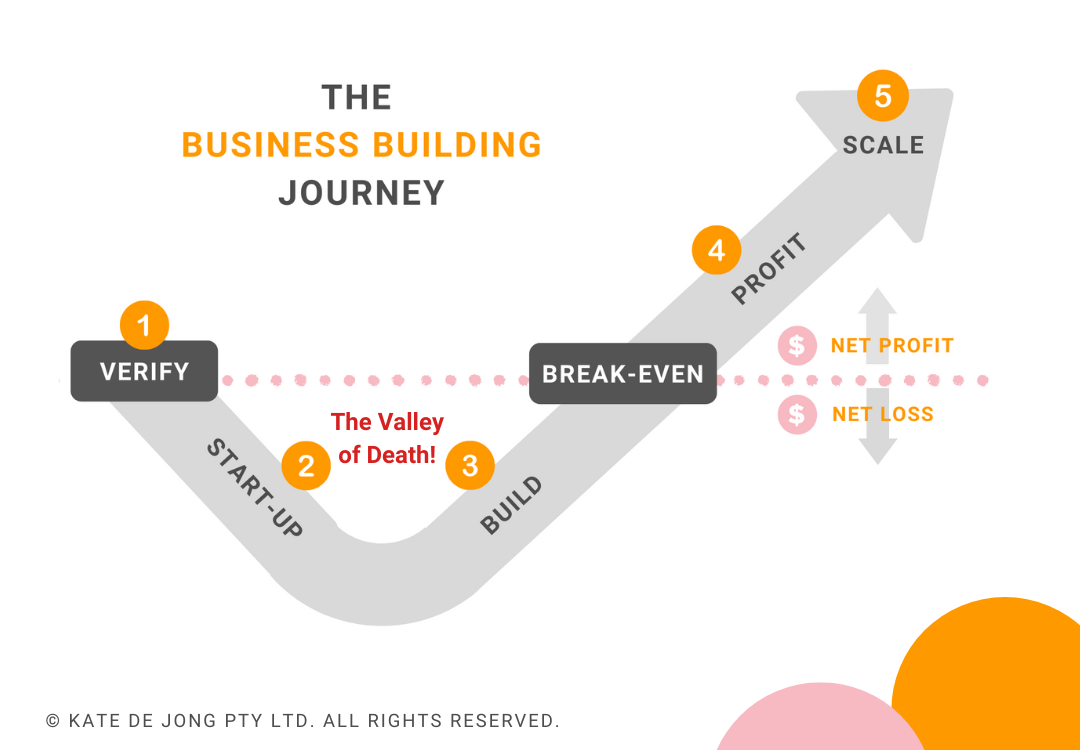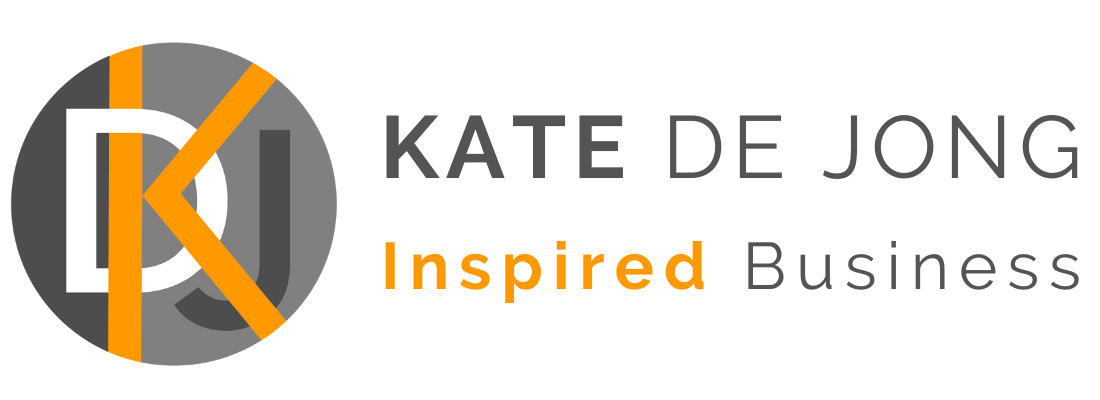As those of you who have built your own business know, the first giant challenge when starting out is to beat the statistics and establish yourself as a stable, profitable business in the first one to three years.
It takes enormous grit, perseverance, and smarts to get through what I refer to as ‘the valley of death’ where 85% of all small businesses fail, between the verify and break-even phase (see below).

When you finally get into a phase of sustainable profit, it’s time to celebrate! You’ve overcome the odds to survive the first three years—a huge milestone.
But most business owners don’t even have time to celebrate when they finally reach stable profit because they’re too busy working themselves into the ground trying to keep all the balls in the air. I know that place well, I’ve been there myself too. It’s not fun at all. You feel like a slave to your business and you can only dream about taking a holiday. You can’t leave your business because it can’t run without you yet.
What to do?
Start working on your business, not in it.
The next big challenge after reaching the profit phase is to find a way to untangle yourself from your business so that it can run and scale without your continuous input. This doesn’t happen overnight and it takes careful strategic planning.
The key to growing your business to the point where it can run without you is to do these four things well:
 Implement Systems and Automation.
Implement Systems and Automation.
Systems and processes are critical, especially if you want to sell your business down the track. Systems result in efficiency, a critical element of a well-oiled business. Wherever you’re doing repetitive tasks, you’ll need to find a way to automate them. There are systems available these days—many of them free—that allow you to automate your workflows and reduce the time required to do your core business.
 Outsource and/or Delegate.
Outsource and/or Delegate.
It’s time to start building a team around you who can do the heavy lifting for you so you can focus on high-value activities like business development and serving your clients. Whether it’s taking on virtual assistants, a contractor, or a staff member, it’s important to start delegating in order to grow. Hire people who have strengths that you don’t have so that your team is well-rounded and effective.
 Marketing Powerfully.
Marketing Powerfully.
You need to get strategic with your marketing and invest in channels that deliver a high return on investment. Have a clear marketing plan with specific goals that will generate the revenue you need. Automate your lead generation to create consistent leads and clients.
 Develop a CEO Mindset.
Develop a CEO Mindset.
Every new level of your business requires a new you. Your mindset needs to grow and expand to allow your business to do the same.
How do you Scale Your Revenue?
Grow Your Revenue with a Scalable Business Model.
Once you’ve covered the four key areas above that allow you to work on your business (not in it) and you’re running as smoothly as possible, it’s time to celebrate again because now you can finally take a holiday!
Hallelujah.
You’ve earned it.
Now (if it feels right for you) it’s time to scale your business so you can increase your profits and enjoy financial freedom and the lifestyle you deserve, without working more. And who doesn’t want that?
But firstly, what’s a scalable business model?
The term ‘scalable’ means that your business has the potential to multiply its revenue with minimal incremental cost. It’s where you uncouple your revenue from your operating expenses in order to easily expand and grow your profits without requiring more of your time and resources.

Scaling a Product Business
If you’re selling digital products, your growth is literally uncapped if you have the right systems and automation in place.
If you’re selling physical products, you can engage a third-party logistics provider to fulfill your online orders so you can scale in an unhindered way.
But how would you scale a service business?
Tips for Scaling a Service-Based Business
The key for service-based business owners is to stop selling your time and start leveraging your time. This can be tricky since the original business was built very much on your expertise, your personality, and your vision for serving others. How do you duplicate yourself? How do you scale up what you do?
The answer is two-fold:
1. Stop trading dollars for hours and start selling a result.
People are willing to pay good money for a specific result. For example, if you’re a personal trainer, you could—aside from offering hourly sessions—also offer a package that delivers a specific outcome, perhaps like ‘Killer abs and booty in 60days’
2. Share your expertise in a one-to-many offering.
How could you develop a program or course that allows you to lead, teach and/or mentor a scalable group of clients?
In order to scale, you need to refine your service offering as well as your target customer. To figure out which of your services you should zero in on, step back and look at the problems you are solving. Look for the most difficult problem that generates the most value for the customer when it’s resolved.
Package your Service like a Product.
Products are offerings that solve specific problems. Take my Inspired Business Collective as an example. It’s an online mastermind group for business owners dedicated to growing their business with ease. After speaking to all my clients, it became apparent to me that they all needed three things to grow their businesses:
- Knowledge of how to grow and scale with ease.
- Build valuable relationships with other business owners.
- Accountability to achieve their goals.
So I structure the Inspired Business Collective to deliver those three things.
It’s a service that I offer, packaged as a product.
To offer your service as a product, you need these three things:
- A unique approach or process.
- Articulate the problem you’re solving for your clients.
- Articulate clearly the results your client will achieve (the benefits).
How could you package your service to deliver a scalable, one-to-many service? The difference is profound in how it frees your time and allows you to make an even bigger impact.
Look at the difference between the two images below. The first image shows how your calendar looks when you’re providing a 1:1 service only. In this case, the service provider is limited to 21 sessions per week. They’ve built free time in their schedule to work on their business, manage admin, and to recharge. As you know, it’s impossible to deliver a 1:1 service all day, every day, without burning out.
Now look at how your calendar looks when you’re delivering one high-value group program that gets amazing results for your clients. And the beauty of the group program is that, if designed right, it provides uncapped growth and revenue, all in the same amount of time input each week. How great is that?!


Do you need help to grow or scale your business with ease?
Our Inspired Business Collective mastermind group is dedicated to helping you grow your impact and profits, minus the struggle. Come on over and check it out now!
Have you downloaded your FREE copy of The Art of Business Building yet?

Discover the Essential Strategies to Market and Grow Your Business, the Easy Way!
Go here to download it now.
In service to your success,
Kate De Jong, PhD
Inspired Business
Business & marketing coach for small business owners
[email protected]
katedejong.com
0424 176 658


 Kate De Jong is a business and marketing strategist for start-ups and small business owners who want to grow their business with ease. Kate is a bestselling author and a Chief Executive Women award-winner for women in leadership. Formerly a consulting engineer for more than fifteen years, Kate left her engineering career in 2012 to pursue her passion and zone of genius—entrepreneurship and marketing — and has never looked back!
Kate De Jong is a business and marketing strategist for start-ups and small business owners who want to grow their business with ease. Kate is a bestselling author and a Chief Executive Women award-winner for women in leadership. Formerly a consulting engineer for more than fifteen years, Kate left her engineering career in 2012 to pursue her passion and zone of genius—entrepreneurship and marketing — and has never looked back!